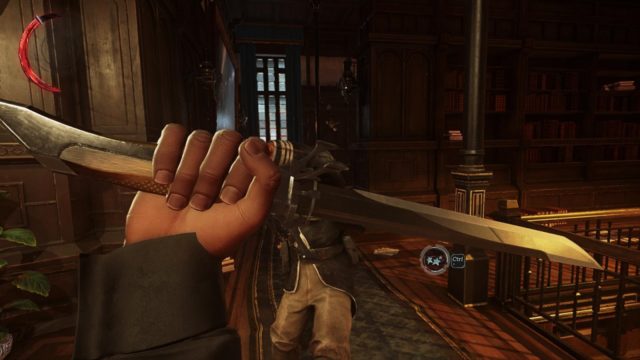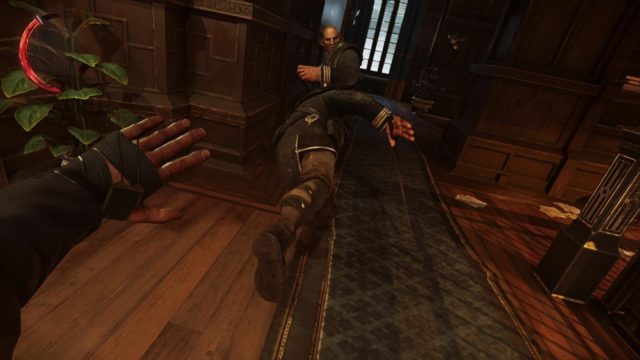Stealth play exists on the tenuous edge between concealment and conflict. Between avoiding NPCs and actively confronting them. When the player is detected most stealth games shift into a different style of play, one focused on either combat or rapid disengagement. Multiple styles of play with skill sets that don’t overlap cleanly, forced to exist within the same game. This divide is a soft-boundary within the simulation. The models of detection and combat operating at different degrees of fidelity, causing a disconnect when you shift from one to the other. This boundary is most obvious when crossed in the other direction. After transitioning from conflict back to concealment AI controlled NPC will eventually “forget” the presence of the player despite potentially having seen one of their friends killed in front of them; behaviour inconsistent with their aggressive search and combat routines. There are many good reasons for handling the simulation in this manner, unfortunately that doesn’t make the state change smoother. Games of the Immersive Sim genre have traditionally provided for a less rigid transition of states. Built around a consistent simulated world, here the state change alters the means and motivation for engaging with the possibility space but not underlying rules governing it.
The spectrum of powers and abilities available to you in Dishonored 2 – along with the underlying simulation rules – don’t entirely resolve this conflict either, though they go some way toward smoothing the transition. What Dishonored 2 does do is play with that threshold between concealment and conflict. Allowing you to remain within that liminal space even in the face of mistakes and sudden occurrences that would otherwise result in fight or flight.

When detected there is a limited window where, if close enough, you are able to punch and then grab an NPC, restraining them in a chokehold. Traditionally when discovered by a patrolling NPC your options are limited. You can attempt to kill them which can be both noisy and messy, or you can accept detection and make a run for it. In Dishonored 2 this moment is extended, stretched out into a window of opportunity. Barely a few seconds but long enough to act, to regain the advantage, rendering the troublesome NPC unconscious and remaining in a concealment state rather than fully breaching the boundary and initiating conflict.
You deal with the immediate concern of being detected, replacing it with the new one of what to do with the body? Having prevented an alert, you now have time to deal with the next problem on your own terms.
If we consider the shift from concealment to conflict as the failure state of stealth, then this ability to incapacitate enemies in your moment of discovery provides partial failure. You have not been entirely successful at remaining hidden, but you have managed to avoid entering outright conflict. The strength of partial failure comes from the way its consequences can spiral outward impacting all future decisions while not directly forcing you into either a different style of play, or a complete restart.
You’ve avoided detection for the moment, but now you need to do something about the unconscious body. Carrying it around means you won’t have access to your sword, and makes movement slower. If you can successfully hide the body you may be in a better position as there will be one less NPC available to potentially discover you. Unfortunately, NPCs in Dishonored 2 can adjust their patrol routes to compensate for missing companions. Removing one might well make things easier for you but not necessarily in the ways you were expecting.
Partial failure such as this also exposes you to more of the game’s systems, as the world state changes so too does the possibility space. An unconscious NPC is an extra element to deal with, a new entry point into the game’s systems to explore, certain opportunities are available now that weren’t before.

These reactive takedowns are not only limited to the moment of initial discovery, you can trigger one any time you are able to stagger an NPC. This can be achieved either by throwing something at them (including another unconscious guard, in what rapidly becomes a comedic escalation), or blocking their sword attack. A way of allowing you to engage in combat, if necessary, without being forced to resort to directly lethal violence. This further extends your ability to take back the initiative in the few seconds before everything spirals out of your control.
Games built on offering players a range of solutions require not only a rich possibility space, but also the time necessary to parse the potential options and choose an appropriate one. If the options available are logical and readable that window doesn’t need to be large; about as long as it takes to stagger and choke an NPC.
The tension of the stealth genre comes from the constant presence of the boundary between concealment and conflict. By allowing partial failure, and therefore partial recovery, Dishonored 2 keeps this division intact by extending the threshold. It creates a liminal space where your failure to remain entirely undetected has consequences, but ones that can be resolved using your existing stealth skill set rather requiring a state change into using those skills necessary for combat or evasion.